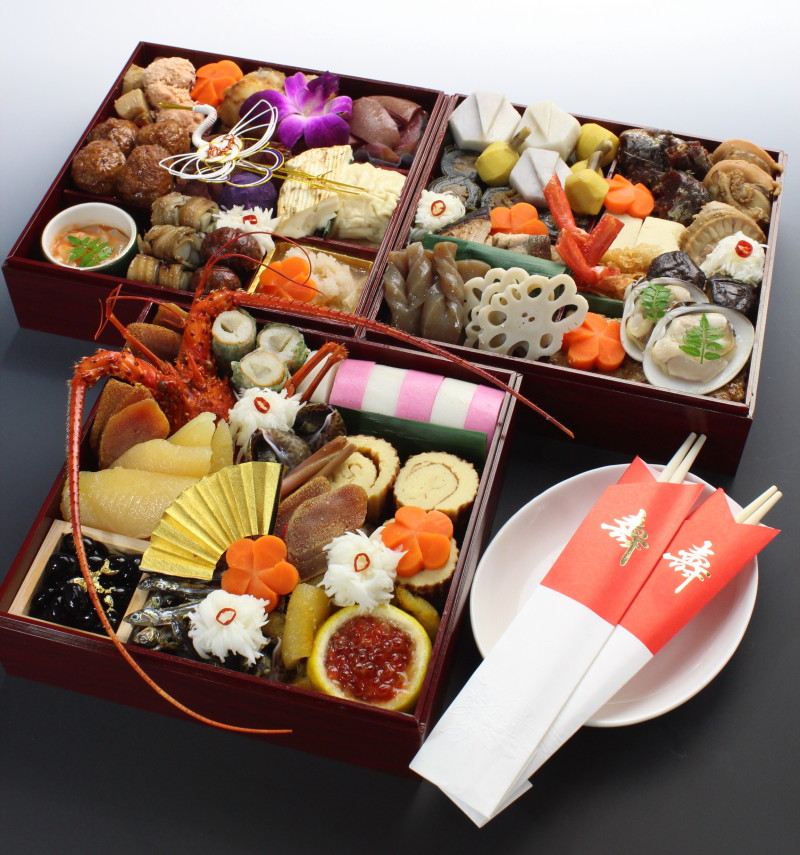
credit: face-magazine
Going back to work seems to be somewhat bittersweet--I miss my students and teachers, but have grown used to traveling around and relaxing :) Although my first post for 2015 was about ice cream, this one will be about traditional Japanese New Year's food, or osechi ryori (you can read about last year's one here ^^). Starting from the Heian Period, this New Year's tradition continues to be one of the most important ones for Japanese people. Prepared a couple of days in advance, the various foods are beautifully arranged in special bento boxes called jubako which are stacked on each other. Each of the foods have their own symbolic meaning and usually last a family a couple of days. Today, people can buy their osechi from grocery and department stores as well as from famous restaurants. Prices vary and can start from 10,000 yen ($100) to over 100,000 yen ($1,000) from the most well-known restaurants. Daimaru was selling some for over 80,000 yen while Daiei had sets starting at 7,500 yen.
This year, I made my own osechi again, but opted to leave out a couple of foods while adding a few new ones. I decided to omit kuri kinton and kuromame (the packages that they came in were too large and expensive for me to eat before the expiration date), but added kinpira and datemaki.
Clockwise: Soba and kamaboko, kinpira, tazukuri, datemaki, wagashi, nishime and ozoni. Definitely not fancy, but I was still very happy with the end result! :)
Soba noodles are often eaten on New Year's Eve to symbolize crossing over to the next year. The noodles can also represent having a long life. Kamaboko is another celebratory food as its colors represents the rising sun of Japan.
I have never made kinpira before, but fell in love with it during one of my kyushokus at my elementary school. I was quite happy with how my first kinpira turned out :) This dish is made with burdock root (gobo) and carrots that have been cooked in a combination of sugar, shoyu, mirin and sake. It symbolizes a long, stable life as gobo is a very long root.
Tazukuri is a popular osechi dish that is made from dried sardines that have been cooked in a sweet soy sauce (shoyu, sugar, mirin and honey). It represents having a bountiful harvest. I would advice you to add a tiny bit of oil to the sauce because my tazukuri ended up sticking together -___-;
This was my first time making datemaki, but I was pleasantly surprised by how it turned out! It's a sweet-rolled omelet mixed with hanpen (a fish paste) and symbolizes auspicious days in addition to wealth and fertility. It also represents wisdom as its shape appears similar to that of a scroll.
Wagashi are traditional Japanese sweets that are often served at tea ceremonies as well as at the end of a fancy meal such as kaiseki-ryori. They can be quite expensive (some sell for over $4 for a single one), but I bought these from Daiei for about 400 yen :) Because they are time-consuming and difficult to make, they are often bought at specialty stores and other shops. I decided to include them because the aesthetics were amazing and it was a nice way to end each meal ^^
Nishime is a simmered dish with a variety of ingredients which are added according to how long they take to cook. Because this is a slow-cooked dish with numerous steps and ingredients, it represents harmonious family relationships.
Hasu/renkon (lotus root) symbolizes looking through the new year because of its holes
Gobo (burdock root) symbolizes a long life as well as strong family roots
Flower-shaped carrots represent fertility as they appear similar to a plum blossom which bears one fruit
One of my favorite dishes to eat on New Year's Day is ozoni which is a soup usually eaten with mochi and vegetables such as mizuna. The soup varies in each region as well as within households. Clear broth is used in certain areas while a miso based broth is used in others. The vegetables vary as well so there is no set recipe.
Thank you so much for reading and I hope you all have a happy, healthy and safe new year!! :)








No comments:
Post a Comment